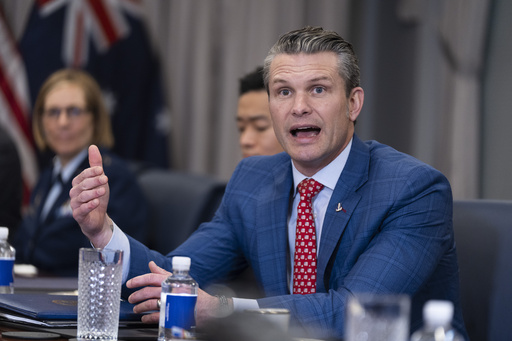BRUSSELS — On Wednesday, U.S. Defense Secretary Pete Hegseth is set to make history as the first member of the new Trump administration to visit NATO headquarters. The purpose of his visit is to provide clarity on how the United States intends to influence the ongoing war in Ukraine as allies express their concerns. With the third anniversary of Russia’s full invasion approaching, many U.S. allies are apprehensive that a successful Russian campaign may extend beyond Ukraine, resulting in a significant security threat across Europe.
President Trump has vowed to swiftly conclude the conflict, stating that the war’s financial burden on American taxpayers is excessive. However, some allies fear that a rapid resolution could lead to an unfavorable agreement for Ukraine. During his visit, Hegseth will participate in a meeting of the Ukraine Defense Contact Group located at NATO’s Brussels headquarters. This group, established by former Defense Secretary Lloyd Austin in 2022, has served as a crucial platform for gathering international support in terms of military aid for Ukraine.
Over the past three years, approximately 50 nations have collectively delivered over $126 billion in weapons and military support to Ukraine. This week’s meeting will mark a significant change, as it will be convened for the first time by the United Kingdom.
As for the upcoming meeting, there is no decision yet regarding who will preside over future gatherings. Hegseth is not expected to announce any new military aid for Ukraine and will not engage in one-on-one discussions with his Ukrainian counterparts. Instead, he will adopt a “listening mode” during both the NATO meeting and the defense ministerial held later this week, according to a U.S. official.
The Pentagon stated that Hegseth would reaffirm Trump’s commitment to seeking a diplomatic resolution to the war in Ukraine as swiftly as possible, while also emphasizing the need for enhanced European leadership in providing security assistance to Ukraine.
The 31 NATO allies are eager to understand the new Trump administration’s approach to the world’s largest security alliance. During the previous Trump administration, relations with European partners became strained when he suggested that the U.S. might not defend countries that failed to meet NATO’s military spending guidelines.
NATO operates under the principle that an assault on one member is an assault on all, warranting a collective response. This principle underpins Ukraine’s quest for security guarantees. A senior NATO diplomat indicated that fostering constructive dialogue with the incoming American administration is vital during this visit, alongside a reaffirmation of U.S. commitment to support Ukraine’s defense efforts.
An anonymous diplomat, who spoke under a common practice for member countries, highlighted that the meeting’s success would hinge on engaging in productive conversations concerning Ukraine’s security needs. Meanwhile, Mike Waltz, Trump’s national security adviser, asserted that European nations must assume responsibility for the ongoing conflict moving forward. He emphasized that while President Trump intends to conclude the conflict, security guarantees will predominantly rest on Europe.
Key topics on the agenda for Thursday’s discussions include Ukraine’s defense requirements and European defense budgets, which have seen significant increases since the onset of hostilities initiated by Putin. An estimated 23 European allies have already met or surpassed the NATO guideline of spending 2% of GDP on defense as of last year. Nonetheless, approximately one-third of members have yet to meet this target, likely making them a focal point for Trump’s upcoming discussions. Recently, Trump pushed for NATO countries to elevate their defense spending to a staggering 5% of GDP—an unprecedented level that not even Poland, the closest ally in terms of defense spending, has achieved yet. Currently, Poland spends over 4% and is projected to near the 5% mark soon.
NATO diplomats estimate that in order to effectively implement new defense strategies in the event of aggression towards allied nations, member states would require military budgets at around 3.5-3.7% of GDP. Leadership within the organization is expected to finalize new defense spending thresholds during their upcoming summit scheduled for June 24-26 in The Hague.




